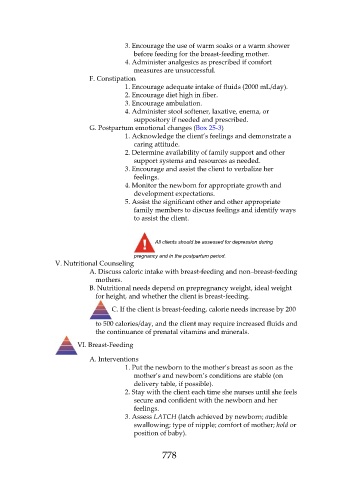Page 778 - Saunders Comprehensive Review For NCLEX-RN
P. 778
3. Encourage the use of warm soaks or a warm shower
before feeding for the breast-feeding mother.
4. Administer analgesics as prescribed if comfort
measures are unsuccessful.
F. Constipation
1. Encourage adequate intake of fluids (2000 mL/day).
2. Encourage diet high in fiber.
3. Encourage ambulation.
4. Administer stool softener, laxative, enema, or
suppository if needed and prescribed.
G. Postpartum emotional changes (Box 25-3)
1. Acknowledge the client’s feelings and demonstrate a
caring attitude.
2. Determine availability of family support and other
support systems and resources as needed.
3. Encourage and assist the client to verbalize her
feelings.
4. Monitor the newborn for appropriate growth and
development expectations.
5. Assist the significant other and other appropriate
family members to discuss feelings and identify ways
to assist the client.
All clients should be assessed for depression during
pregnancy and in the postpartum period.
V. Nutritional Counseling
A. Discuss caloric intake with breast-feeding and non–breast-feeding
mothers.
B. Nutritional needs depend on prepregnancy weight, ideal weight
for height, and whether the client is breast-feeding.
C. If the client is breast-feeding, calorie needs increase by 200
to 500 calories/day, and the client may require increased fluids and
the continuance of prenatal vitamins and minerals.
VI. Breast-Feeding
A. Interventions
1. Put the newborn to the mother’s breast as soon as the
mother’s and newborn’s conditions are stable (on
delivery table, if possible).
2. Stay with the client each time she nurses until she feels
secure and confident with the newborn and her
feelings.
3. Assess LATCH (latch achieved by newborn; audible
swallowing; type of nipple; comfort of mother; hold or
position of baby).
778

